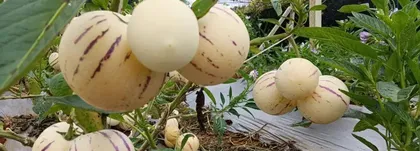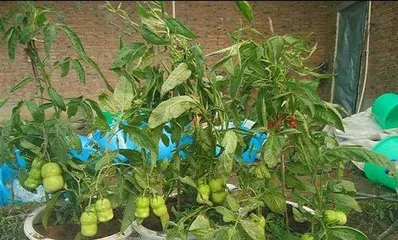Abstract: Ginseng fruit is a highly nutritious and valuable fruit, rich in nutritional components and health benefits, making it highly favored in the market. With the increasing consumer demand for healthy foods, the market prospects for ginseng fruit are becoming increasingly broad. This article will detail the cultivation methods and key care points for ginseng fruit...
Ginseng fruit is a highly nutritious and valuable fruit, rich in nutritional components and health benefits, making it highly favored in the market. With the increasing consumer demand for healthy foods, the market prospects for ginseng fruit are becoming increasingly broad. This article will detail the cultivation methods and key care points for ginseng fruit, helping you create a high-yield, high-quality ginseng orchard.

Understanding the Characteristics of Ginseng Fruit
Ginseng fruit is native to South America, mainly distributed in countries such as Brazil, Peru, and Colombia, and is a fruit of the Moraceae family. Ginseng fruit is round or oval in shape, with a green or purplish-red skin, and is rich in nutrients such as vitamin C, calcium, and iron. It has health benefits including cancer prevention, anti-aging, and immune system enhancement.
Selecting Suitable Seedlings
Selecting suitable seedlings is key to successfully growing ginseng fruit. You should choose healthy, well-growing seedlings with well-developed root systems, and avoid seedlings with many pests and diseases. At the same time, when purchasing seedlings, pay attention to selecting varieties that are adapted to the local climate conditions.

Environmental Requirements for Ginseng Fruit Growth
Ginseng fruit prefers a warm and humid environment, with a suitable growing temperature of 18-28°C. At the same time, fertile, well-drained land should be chosen for planting. Regular fertilization and watering are necessary to keep the soil moist.
Rational Ginseng Orchard Design
A rational ginseng orchard design can improve the yield and quality of ginseng fruit. The design should be based on factors such as local climate conditions, soil properties, and planting scale, with reasonable allocation of parameters like planting density, row spacing, and tree height.
Scientific Pruning of Ginseng Fruit Trees
Pruning ginseng fruit trees can promote branch bifurcation and flower bud growth, increasing fruit yield and quality. Pruning should be done during the canopy growth period, retaining the main trunk and basic framework branches, which is conducive to the transport and full utilization of water and nutrients.

Appropriate Fertilization Methods
Fertilization is key to ensuring the growth, development, and yield of ginseng fruit. Fertilizers such as organic fertilizers, inorganic fertilizers, and trace elements should be used reasonably according to the needs of different growth stages, avoiding excessive fertilization that can lead to soil pollution and a decline in fruit quality.
Strengthening Pest and Disease Control
During the cultivation process, ginseng fruit is susceptible to pests and diseases, which affects yield and quality. Preventive measures should be taken to strengthen pest and disease control, avoiding the use of toxic and harmful chemical pesticides and choosing eco-friendly methods.
Timely Fruit Harvesting
Ripe fruits should be harvested in a timely manner to prevent them from aging and deteriorating, which would affect their quality. Appropriate tools should be used for harvesting to avoid damaging the fruits, which would impact their taste and edible quality.
Processing and Utilization of Ginseng Fruit
Ginseng fruit can be eaten fresh, processed, or made into food products. Processing and utilization should be based on the characteristics of the ginseng fruit variety and market demand to increase its added value and economic benefits.
Marketing Strategies for Ginseng Orchards
The marketing strategy for a ginseng orchard should consider market demand and consumer preferences, developing sales plans and brand images that meet market needs to enhance brand competitiveness and market share.
Ecological and Environmental Protection in Ginseng Orchards
The cultivation and management of ginseng orchards should comply with environmental protection regulations, promoting ecological planting and organic farming techniques to reduce pesticide use and soil pollution, protect the ecological environment, and enhance the level of sustainable agricultural development.
Scientific Management of Ginseng Orchards
Scientific management of ginseng orchards includes multiple aspects such as unified planning, rational planting, scientific fertilization, timely pruning, and prompt pest and disease control. Management should be based on the actual situation to improve the production and economic efficiency of the ginseng orchard.
Brand Building for Ginseng Orchards
Brand building for ginseng orchards includes several aspects such as brand positioning, brand image design, and brand promotion and publicity. It is necessary to build a brand with strong market competitiveness and influence to lead industry development.
Strengthening Technical Training and Exchange
Strengthening technical training and exchange can improve the level of ginseng fruit cultivation and management, enhancing the competitiveness and innovation of the ginseng fruit industry. Various forms such as technical exchange meetings and on-site observations can be organized to promote industry cooperation and mutual development.
Ginseng fruit is a fruit with broad market prospects. Its cultivation and management require comprehensive management and scientific planning to increase yield and quality. At the same time, it is necessary to strengthen pest and disease control and ecological and environmental protection, promote ecological planting and organic farming techniques, and achieve sustainable development.